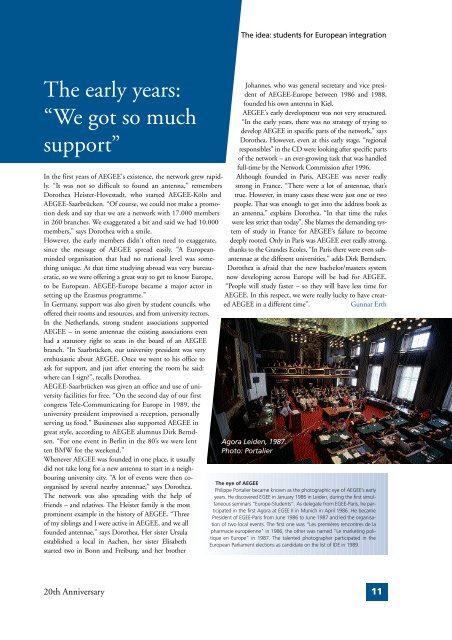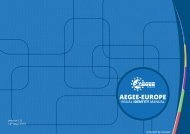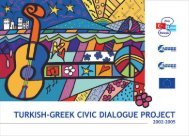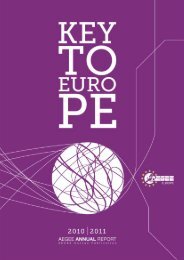You also want an ePaper? Increase the reach of your titles
YUMPU automatically turns print PDFs into web optimized ePapers that Google loves.
The early years:<br />
“We got so much<br />
support”<br />
In the first years of <strong>AEGEE</strong>'s existence, the network grew rapidly.<br />
“It was not so difficult to found an antenna,” remembers<br />
Dorothea Heister-Hovestadt, who started <strong>AEGEE</strong>-Köln and<br />
<strong>AEGEE</strong>-Saarbrücken. “Of course, we could not make a promotion<br />
desk and say that we are a network with 17.000 members<br />
in 260 branches. We exaggerated a bit and said we had 10.000<br />
members,” says Dorothea with a smile.<br />
However, the early members didn't often need to exaggerate,<br />
since the message of <strong>AEGEE</strong> spread easily. “A <strong>Europe</strong>anminded<br />
organisation that had no national level was something<br />
unique. At that time studying abroad was very bureaucratic,<br />
so we were offering a great way to get to know <strong>Europe</strong>,<br />
to be <strong>Europe</strong>an. <strong>AEGEE</strong>-<strong>Europe</strong> became a major actor in<br />
setting up the Erasmus programme.”<br />
In Germany, support was also given by student councils, who<br />
offered their rooms and resources, and from university rectors.<br />
In the Netherlands, strong student associations supported<br />
<strong>AEGEE</strong> – in some antennae the existing associations even<br />
had a statutory right to seats in the board of an <strong>AEGEE</strong><br />
branch. “In Saarbrücken, our university president was very<br />
enthusiastic about <strong>AEGEE</strong>. Once we went to his office to<br />
ask for support, and just after entering the room he said:<br />
where can I sign?”, recalls Dorothea.<br />
<strong>AEGEE</strong>-Saarbrücken was given an office and use of university<br />
facilities for free. “On the second day of our first<br />
congress Tele-Communicating for <strong>Europe</strong> in 1989, the<br />
university president improvised a reception, personally<br />
serving us food.” Businesses also supported <strong>AEGEE</strong> in<br />
great style, according to <strong>AEGEE</strong> alumnus Dirk Berndsen.<br />
“For one event in Berlin in the 80’s we were lent<br />
ten BMW for the weekend.”<br />
Whenever <strong>AEGEE</strong> was founded in one place, it usually<br />
did not take long for a new antenna to start in a neighbouring<br />
university city. “A lot of events were then coorganised<br />
by several nearby antennae,” says Dorothea.<br />
The network was also spreading with the help of<br />
friends – and relatives. The Heister family is the most<br />
prominent example in the history of <strong>AEGEE</strong>. “Three<br />
of my siblings and I were active in <strong>AEGEE</strong>, and we all<br />
founded antennae,” says Dorothea. Her sister Ursula<br />
established a local in Aachen, her sister Elisabeth<br />
started two in Bonn and Freiburg, and her brother<br />
<strong>20</strong>th Anniversary<br />
The idea: students for <strong>Europe</strong>an integration<br />
Johannes, who was general secretary and vice president<br />
of <strong>AEGEE</strong>-<strong>Europe</strong> between 1986 and 1988,<br />
founded his own antenna in Kiel.<br />
<strong>AEGEE</strong>'s early development was not very structured.<br />
“In the early years, there was no strategy of trying to<br />
develop <strong>AEGEE</strong> in specific parts of the network,” says<br />
Dorothea. However, even at this early stage, “regional<br />
responsibles” in the CD were looking after specific parts<br />
of the network – an ever-growing task that was handled<br />
full-time by the Network Commission after 1996.<br />
Although founded in Paris, <strong>AEGEE</strong> was never really<br />
strong in France. “There were a lot of antennae, that’s<br />
true. However, in many cases these were just one or two<br />
people. That was enough to get into the address book as<br />
an antenna,” explains Dorothea. “In that time the rules<br />
were less strict than today”. She blames the demanding system<br />
of study in France for <strong>AEGEE</strong>'s failure to become<br />
deeply rooted. Only in Paris was <strong>AEGEE</strong> ever really strong,<br />
thanks to the Grandes Ecoles. “In Paris there were even subantennae<br />
at the different universities,” adds Dirk Berndsen.<br />
Dorothea is afraid that the new bachelor/masters system<br />
now developing across <strong>Europe</strong> will be bad for <strong>AEGEE</strong>.<br />
“People will study faster – so they will have less time for<br />
<strong>AEGEE</strong>. In this respect, we were really lucky to have created<br />
<strong>AEGEE</strong> in a different time”. Gunnar Erth<br />
Agora Leiden, 1987.<br />
Photo: Portalier<br />
The eye of <strong>AEGEE</strong><br />
Philippe Portalier became known as the photographic eye of <strong>AEGEE</strong>’s early<br />
years. He discovered EGEE in January 1986 in Leiden, during the first simultaneous<br />
seminars “<strong>Europe</strong>-Students”. As delegate from EGEE-Paris, he participated<br />
in the first Agora at EGEE II in Munich in April 1986. He became<br />
President of EGEE-Paris from June 1986 to June 1987 and led the organisation<br />
of two local events. The first one was "Les premières rencontres de la<br />
pharmacie européenne" in 1986, the other was named "Le marketing politique<br />
en <strong>Europe</strong>" in 1987. The talented photographer participated in the<br />
<strong>Europe</strong>an Parliament elections as candidate on the list of IDE in 1989.<br />
11







